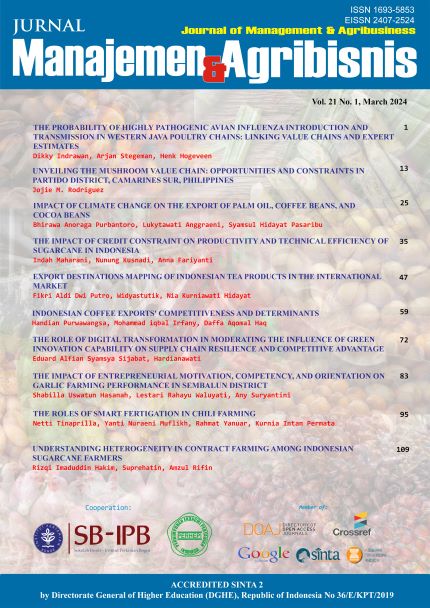The Why and Who Facets of Strategic Horticulture Enterprise Systems
Abstract
Actual Indonesia's inflation rate is higher than the government's inflation target. One of the reasons is that the dataset for calculating food group inflation is asymmetric due to incomplete supply and demand data. This study tries to overcome asymmetric data constraints by providing an enterprise system for strategic horticultural commodities (SHES). The research method used the first three Zachman Framework perspectives: the executive perspective contextual view, the business management perspective conceptual view, and the architect's perspective physical view, each evaluated using the Why and Who facets. Respectively, the result of the Why facet is about business drivers and motivation intention: vision, mission, and goals; strategic goals and the SHES model's entity goals/objectives; and system development rules, requirements, and functionality representation. The Who facets results are associated with responsibility assignments of farmers, merchants, sub-district data collectors, District Agriculture offices, developers, users, and managers (tested using high-fidelity prototypes/mockups). With SHES, data and information collection becomes systematic and holistic, immediately in the form of real-time data from farmers and traders. Access to SHES uses the farmer's/trader's mobile phone. Thus, data recapitulation, from village to sub-district, district, to provincial and national, will likely be based on reality/data facts in the field.
Keywords: Why and Who facets, real-time data, strategic horticultural commodities, high-fidelity prototype, Zachman framework
Authors
Authors who publish with this journal agree to the following terms:
- Authors retain copyright and grant the journal right of first publication with the work simultaneously licensed under a Creative Commons Attribution License that allows others to share the work with an acknowledgement of the work's authorship and initial publication in this journal.
- Authors are able to enter into separate, additional contractual arrangements for the non-exclusive distribution of the journal's published version of the work (e.g., post it to an institutional repository or publish it in a book), with an acknowledgement of its initial publication in this journal.
- Authors are permitted and encouraged to post their work online (e.g., in institutional repositories or on their website) prior to and during the submission process, as it can lead to productive exchanges, as well as earlier and greater citation of published work (See The Effect of Open Access).

